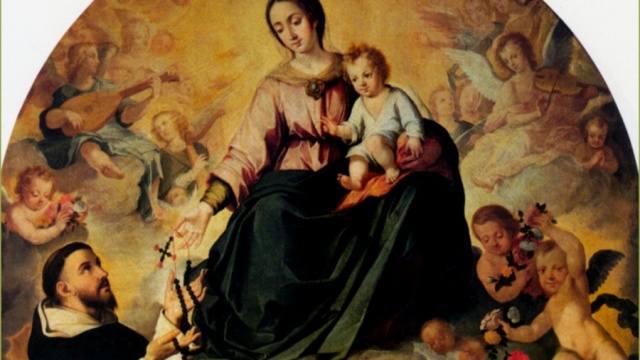SEARCH

"Wonder not that you have obtained so little fruit by your labours, you have spent them on barren soil, not yet watered with the dew of Divine Grace. When God willed to renew the face of the earth, He began by sending down on it the fertilizing rain of the Angelic Salutation. Therefore preach my Psalter composed of 150 Angelic Salutations and 15 Our Fathers, and you will obtain an abundant harvest.”The Psalter of the 150 Angelic Salutations is, of course, the Rosary. Think about that for a second: When God wanted to renew the earth, He began by sending down upon it the fertilizing rain of the Angelic Salutation. That is when the Angel Gabriel said, “Hail Mary, full of Grace. The Lord is with you.” Just saying those words brings down the fertilizing rain of God’s Divine Grace. So that means that it doesn’t matter if you mutter them, or say them while thinking about supper (not that you should; you should try to mean what you say); they bring down God’s Divine Grace. Combine that with meditating on moments in the life of Jesus…. There’s nothing that can be bad about praying the Rosary – or even absentmindedly just saying the words of the Angelic Salutation! (Which I find myself doing now, more often than not.) I still find the Rosary hard (I’m more of a Breviary and Divine Mercy Chaplet kind of person), but this little discovery about St. Dominic has made a huge difference in my life. Why don’t you try it? Especially in places where you find that your prayer is not fruitful, try adding a few Hail Marys for the barren soil to be fertilized with some Divine Grace. Next Friday, we celebrate another Marian Feast: the Birth of Mary. St. Augustine said that Mary's birth is connected to Jesus' saving work. I suppose that if we can say that God's Saving Grace began with the Annunciation, could we also say that for that to happen, the soil of Mary's heart had to have been prepared? There was definitely some preventative Saving Grace at work from the moment of Mary's conception! St. Augustine says that Mary is "the flower of the field from whom bloomed the precious lily of the valley." That's something to think about as we make it through the week. Next week, what’s up with all those apparitions? Read all my posts about Mary: Deacon-structing Mary Part 1: Full of Grace Deacon-structing Mary Part 2: The Assumption Deacon-structing Mary Part 3: The Rosary Deacon-structing Mary Part 4: Apparitions Deacon-structing Mary Part 5: Mary in the Americas Deacon-structing the Hail Mary - Image: Virgin Presenting Rosary to St. Dominic by Bartolomé Esteban Murillo (1638-1640).
